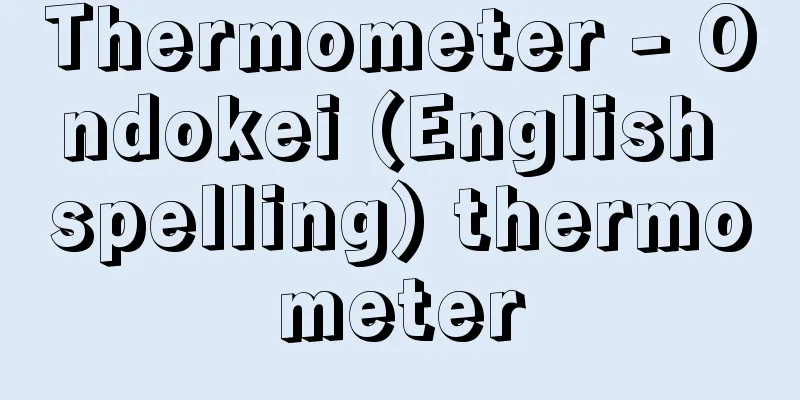Ionosphere - denriken (English spelling)

|
In the upper atmosphere, the degree of ionization begins to increase at an altitude of about 70 kilometers, and increases with altitude. This region was once called the ionosphere, focusing on its electromagnetic characteristics, but is now called the ionosphere. There is no clear upper limit to the altitude, but in practice it often refers to an altitude of 400 to 500 kilometers, and anything above that is often called the plasmasphere. According to the classification of the atmosphere based on the structure of temperature distribution, this altitude region is the thermosphere. The high ionization level of the upper atmosphere is due to the ionizing effect of X-rays and extreme ultraviolet rays (extreme ultraviolet light) coming from the sun. This ionizes atoms and molecules in the atmosphere, creating pairs of free electrons and ions. In the ionosphere, there are equal amounts of free electrons and ions, and the ionosphere is electrically neutral overall and has high electrical conductivity. Even in polar regions with no solar radiation, there are intermittent flows of electrons and protons that flow from the magnetosphere into the thermosphere and cause the aurora to shine. The impact of these particles ionizes the atmosphere, forming the ionosphere. The ionosphere has high electrical conductivity, so it reflects radio waves. For this reason, it is used for long-distance wireless communication using shortwave radio waves. [Toshihiro Ogawa] Structure of the ionosphereOne of the basic physical quantities of the ionosphere is the density of free electrons. When electromagnetic waves that enter the ionosphere are reflected, there is a certain relationship between the frequency of the electromagnetic waves and the electron density, so the electron density is also important in practical terms. The ionosphere is divided into the D, E, and F regions based on the shape of the vertical distribution of electron density and the magnitude of density. These regions are generated by different mechanisms, and the ion components that make them up are completely different, so each region behaves uniquely. (1) D region: A region at an altitude of about 70 to 85 kilometers. It is mainly formed by the ionization of nitric oxide, a trace gas component in the atmosphere, by the Lyman-alpha radiation from the sun. The electron density is about 1 to 10 billion per cubic meter. At night, when there is no direct sunlight, the density decreases to about 100 to 1 billion. Nitric oxide ions, the primary ions, are rapidly converted into hydrogen ions with the addition of water, so the latter ions are the main component. The atmospheric pressure in this region is relatively high, so there are many collisions between free electrons and atmospheric molecules, and electromagnetic waves passing through this region are attenuated. Therefore, for shortwave communication, it acts as an absorbing layer rather than a reflecting layer for radio waves. (2) E region: A region at an altitude of about 85 to 160 kilometers. It is produced by the ionization of oxygen molecules by the Lyman-beta light of the sun and the ionization of nitrogen and oxygen molecules by soft X-rays. The electron density is about 100 billion per cubic meter, but at night, when there is no direct sunlight, it drops to about 1 billion. Since this is a region where ion exchange reactions are actively occurring, the primary ions are converted and the main ion components are nitric oxide ions and oxygen molecular ions. The sporadic E layer, which sometimes occurs at night, is a thin layer several kilometers wide at an altitude where long-lived metal ions are accumulated by the vertical focusing action of neutral atmospheric winds. The metal ions are likely to originate from meteors. The electric current flowing through this E region causes changes in the geomagnetic field on the ground, and its existence has been observed since ancient times. (3) F region: A region above an altitude of about 160 kilometers. It is formed mainly by the ionization of oxygen atoms by the solar extreme ultraviolet rays, and the main component of the ions is oxygen atomic ions. The electron density is about 100 billion to 1 trillion per cubic meter, and is maximum at an altitude of 200 to 300 kilometers. The decrease in density at night is smaller than in other regions, and long-distance shortwave wireless communication utilizes the propagation of this region. The electron density in the F region changes greatly with the solar activity cycle, and also fluctuates greatly due to temporary disturbances, such as ionospheric storms that occur in parallel with geomagnetic storms. [Toshihiro Ogawa] “Space Physics” by Tatsuzo Obayashi (1970, Shokabo) ▽ “Introduction to Geophysics” (edited by Minoru Kojima, 1990, University of Tokyo Press) ▽ “Space Environmental Science” (edited by Tadanori Onto and Katsuhide Maruhashi) (2000, Ohmsha)” [References] | | | | | |Source: Shogakukan Encyclopedia Nipponica About Encyclopedia Nipponica Information | Legend |
|
超高層大気では、高度約70キロメートルあたりから大気の電離度が増え始め、高度とともに電離度は高くなっている。そこでこの領域を、電磁気的特徴に着目して、かつては電離層とよんだが、いまは電離圏という。高度の上限のほうは、はっきりした境目がないが、実際上高度400~500キロメートルまでをさすことが多く、それより上部はプラズマ圏とよばれることが多い。気温分布の構造からみた大気の区分けによると、熱圏がこの高度領域にあたる。 超高層大気の電離度が高いのは、太陽からやってくるX線や極紫外線(極紫外光)の電離作用による。それによって大気中の原子や分子が電離し、遊離した自由電子とイオンの対がつくられるからである。電離圏内では、自由電子とイオンは同量存在し、全体としては電気的に中性であり、電気伝導度が高い。日射のない極地域でも、磁気圏から熱圏に流入してオーロラを光らせるような、電子や陽子の粒子流が間欠的に存在するので、これら粒子の衝撃によって大気は電離し、電離圏が形成される。電離圏は電気伝導度が高いので、電波を反射する。このため短波電波を使った長距離無線通信に利用されている。 [小川利紘] 電離圏の構造電離圏の基本的な物理量の一つとして自由電子の密度がある。電離圏に入射した電磁波が反射される場合、入射する電磁波の周波数と電子密度との間には一定の関係があるので、電子密度は実用上も重要な意味をもっている。電離圏は電子密度の高度分布の形と密度の大きさから、D領域、E領域、F領域に分けられる。これらの領域の生成機構には違いがあって、構成するイオンの成分もまったく異なり、それぞれ独自のふるまいをする。 (1)D領域 高度約70~85キロメートルの領域。主として、太陽ライマン・アルファ光によって、大気中の微量気体成分である一酸化窒素が電離してできる。電子密度は1立方メートル当り10億個から100億個ほどである。太陽光の直射がなくなる夜間は、密度は1億から10億ほどに減る。一次生成イオンである一酸化窒素イオンは、急速に水の付加した水素イオンに変換されるので、後者のイオンが主成分となっている。この領域は気圧が比較的高いので、自由電子と大気分子との衝突頻度が高く、そのためこの領域を通過する電磁波は減衰を受ける。したがって、短波通信に対しては、電波の反射層としてよりむしろ吸収層として働く。 (2)E領域 高度約85~160キロメートルの領域。太陽ライマン・ベータ光による酸素分子の電離および軟X線による窒素分子と酸素分子の電離によって生成される。電子密度は1立方メートル当り1000億個程度であるが、太陽光の直射がない夜間は10億個ほどに減る。イオンの交換反応が活発におこっている領域なので、一次生成イオンは変換されて、主たるイオン成分は一酸化窒素イオンと酸素分子イオンである。夜間ときおり発生するスポラディックE層は、寿命の長い金属イオンが、中性大気の風による鉛直収束作用によって、高度幅数キロメートルの薄い層に集積したものである。金属イオンは流星が起源であろう。このE領域に流れる電流は地上の地磁気変化を引き起こし、その存在は古くから観測されている。 (3)F領域 高度約160キロメートルより上の領域。太陽極紫外線によって主として酸素原子が電離してできたもので、イオンの主成分は酸素原子イオンである。電子密度は1立方メートル当り1000億個から1兆個程度で、高度200~300キロメートルの間で最大となる。夜間の密度減少は他の領域に比べて少なく、短波の長距離無線通信はこの領域の伝搬を利用する。F領域の電子密度は太陽活動サイクルで大きく変わり、また磁気嵐(あらし)に並行しておこる電離圏嵐のように、一時的な擾乱(じょうらん)によっても大きく変動する。 [小川利紘] 『大林辰蔵著『宇宙空間物理学』(1970・裳華房)』▽『小嶋稔編『地球物理概論』(1990・東京大学出版会)』▽『恩藤忠典・丸橋克英編著『宇宙環境科学』(2000・オーム社)』 [参照項目] | | | | | |出典 小学館 日本大百科全書(ニッポニカ)日本大百科全書(ニッポニカ)について 情報 | 凡例 |
<<: Ionospheric storm (English spelling)
Recommend
Railing - Koran
〘Noun〙 = kouran (railing) ① ※Konjaku (around 1120)...
Eye Bank - gankyuuginkou (English spelling) eye bank
Also known as an eye bank, these are institutions...
Overhead power transmission line
...To solve these problems, air-pipe transmission...
Asukayama
This hill is located at the end of the Yamanote P...
Kozakai [town] - Kozakai
A former town in Hoi District, southeastern Aichi ...
Peleliu [island] - Peleliu
A raised coral reef in the western Pacific Ocean, ...
Sodium hydroxide - Sodium hydroxide
A hydroxide of sodium. It is also known as causti...
Independent School
… The British school system is a dual-track syste...
Microeconomics - Microeconomics
A field of study that microscopically analyzes th...
texere
…An organic group of cells consisting of one or s...
Kyoogokokuji Temple
A Shingon Buddhist temple located in Kujo-cho, Min...
nuclide abundance ratio
...Of the elements that occur naturally, there ar...
Pelopidas jansonis (English spelling)
...In the genus Pelopidas, the Brown Skipper Pelo...
Battle of Kalame - Battle of Kalame
...The Palestinian National Charter, adopted in J...
Koinumaru no ho - Koinumaru no ho
A ho in Issai County, Harima Province. It was also...
![Upper [village] - Ue](/upload/images/67caf97d73025.webp)








